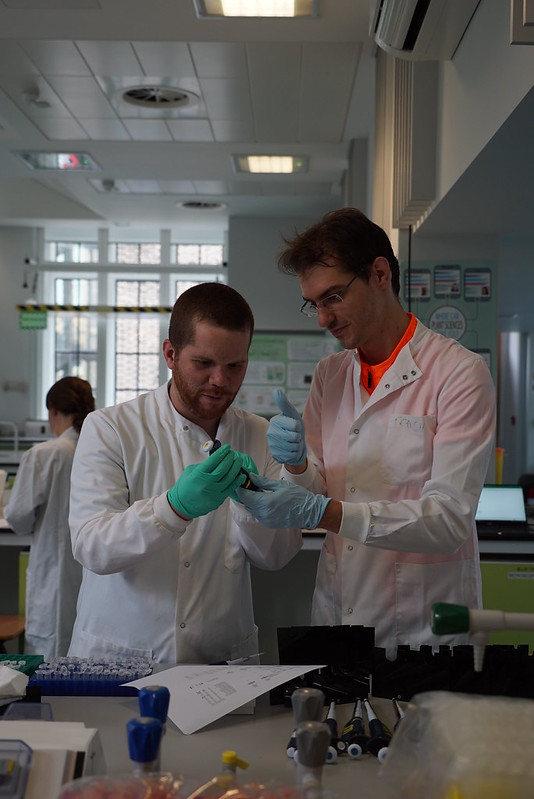David Tong's 2009 Quantum Field Theory lectures at the Perimeter Institute Updated 2025-07-16
Lecture notes: Quantum Field Theory lecture notes by David Tong (2007).
By David Tong.
DC SQUID Updated 2025-07-16
Two parallel Josephson junctions.
In Ciro's ASCII art circuit diagram notation:
|
+-+-+
| |
X X
| |
+-+-+
| DDR SDRAM Updated 2025-07-16
de Broglie relations Updated 2025-07-16
Deep learning is mostly matrix multiplication Updated 2025-07-16
Phase transition Updated 2025-07-16
TODO can anything interesting and deep be said about "why phase transition happens?" physics.stackexchange.com/questions/29128/what-causes-a-phase-transition on Physics Stack Exchange
History of the Josephson effect Updated 2025-07-16
In 1962 Brian Josephson published his inaugural paper predicting the effect as Section "Possible new effects in superconductive tunnelling".
In 1963 Philip W. Anderson and John M. Rowell published their paper that first observed the effect as Section "Possible new effects in superconductive tunnelling".
Some golden notes can be found at True Genius: The Life and Science of John Bardeen page 224 and around. Philip W. Anderson commented:
Photoelectric effect Updated 2025-07-16
No matter how hight the wave intensity, if it the frequency is small, no photons are removed from the material.
This is different from classic waves where energy is proportional to intensity, and coherent with the existence of photons and the Planck-Einstein relation.
Photoelectric effect by UCSB Physics Lecture Demonstrations (2021)
Source. Stone garden Updated 2025-07-16
The literal Chinese name says it all: "Fake Mountain". The stones evoke the feeling of the beautiful rock mountains of China.
The term "奇石假山" (qi2 shi2 jia3 shan1, lit. "weird shaped stone fake mountain") is also used, almost as a synonym by many people, since the stones are often chose in interesting shapes. Choosing the right stone is basically an art form in itself.
The stones used are generally limestone, which as a sedimentary rock is weaker, and more likely to be eroded into interesting shapes.
SuperCollider Updated 2025-07-16
How to play scores and save them to files is discussed at: doc.sccode.org/Guides/Non-Realtime-Synthesis.html
They have a nice looking IDE, but running anything from the command-line interface is super hard, much unlike Csound. How to get a decent hello world: stackoverflow.com/questions/65360414/how-to-play-a-supercollider-file-non-interactively-from-the-terminal-command-lin
Sample composition with custom synths + notes: sccode.org/1-5cl
leanpub.com/ScoringSound looks like a decent tutorial, it is basically the Csound FLOSS manual for SuperCollider.
Boitatech Updated 2025-07-16
Some people from them contacted Ciro Santilli after Ciro's initial publishing of CIA 2010 covert communication websites.
After a quick Discord chat with them, it was apparent that these people were really cool and knowledgeable.
Also many of them seem to think university is broken and just go hack straigh away.
Also they don't seem to need sleep. Go figure!
With pepole like this, there's hope for Brazil: Section "What poor countries have to do to get richer".
Cosmological event horizon Updated 2025-07-16
Kardashev scale Updated 2025-07-16
Ciro Santilli's given name Updated 2025-07-16
"Ciro" is "Cyrus" from Cyrus the Great in both Portuguese and Italian (although with very different pronunciations), thus doubly appropriate given that Ciro Santilli was born in Brazil, and has Italian ancestry.
After he conquered Babylon in 539 BC from the hands Neo-Babylonian Empire, Cyrus the Great did a great service to the Hebrews by allowing war prisoners that were held in Babylon to back to their home Judea, thus terminating the Babylonian captivity. These Jews were imprisoned because they had previously fought a war or revolted against the Neo-Babylonian Empire and lost. As Wikipedia puts it:He is therefore viewed extremely positively in the good old book. Ciro was quite happy about this name choice by his father, given the human rights connotations of the figure and Ciro Santilli's self perceived compassionate personality.
According to Isaiah 45:1 of the Hebrew Bible, God anointed Cyrus for this task, even referring to him as a messiah (lit. 'anointed one'); Cyrus is the only non-Jewish figure in the Bible to be revered in this capacity.
Particularly fun things related to modern Cyrus are:
Because it belongs to some relatively obscure character of the Bible, the name it has been mostly passed on by writing to every single Christian country, and every single language came up with different way of saying it, because the only place they would possibly hear that name said out loud would be in Church!
As of 2020, the country in which the name is most popular in undoubtedly Italy. In Brazil, it is definitely not common, but also not completely unheard of either, e.g. Ciro Gomes is a notable Brazilian politician.
And Ciro responds to all the versions of the name that he knows of. These include:and glad to add any new ones as they come.
- English:
- direct English reading of "Ciro" as "See Roll". Not the most cultured, but its what things tend to converge to, especially in highly international environments where it would be impossible to try and learn the origin of everyone's name! So it's fine. Slightly too close to "zero" for comfort.
- Cyrus, the actual English version of the name. Ciro was so happy when his elderly English neighbour who went to Eton College, upon recognizing what Ciro was, immediately said: "Ah, Cyrus the Great!" He was the cutest, and he had some culture. Many/most English speaking people can't or won't be very sure about the spelling, but the sound of the name has a distinctly exotic feel to it, and the sounds are immediately recognized without sound ambiguity (unlike Ciro vs Zero).
- French:
- Portuguese: "See Ru" with accent on See, and rolling r, and very weak "u". Some people might have some doubt of how to spell it and will ask for confirmation if needed, though many/most will get it right. Not particularly exotic like it is for English speakers.
- Italian: "Chee Ro" with accent on Chee and rolling r. Widely understood and correctly spelled, more than in any other language. Not exotic at all, could be any random dude from Naples.
- "fratm Ciruzzo": reserved for the Napolitan mates. It means "my bro little Ciro" in Napolitan. The "m" in fratm is a possessive inflection ("my", "mio", but on the same word), and "frat" is of course something like he standard Italian fratello (brother).
- www.urbandictionary.com/define.php?term=fratm. "Fratello" is the Italian standard for "brother". "Fra'" appears to be a variant.
- Ciruzzo means "little Ciro", i.e. it is a diminutive of Ciro, or more precisely a term of endearment. In Italian the correct name is "Vezzeggiativi":
- "fratm Ciruzzo": reserved for the Napolitan mates. It means "my bro little Ciro" in Napolitan. The "m" in fratm is a possessive inflection ("my", "mio", but on the same word), and "frat" is of course something like he standard Italian fratello (brother).
- German: Kyrus. Because Cyrus the Great is known Kyrus II. (Cyrus the Second, his grandfather was also called Cyrus), Ciro once joked to a German friend that he should call him Kyrus III! He liked that.
He is actually quite happy when people use the name in their own language, because that means they understand the origin of the name.
Some Ciro's of interest:
System of units Updated 2025-07-16
The key thing in a good system of units is to define units in a way that depends only on physical properties of nature.
Ideally (or basically necessarily?) the starting point generally has to be discrete phenomena, e.g.
- number of times some light oscillates per second
- number of steps in a quantum Hall effect or Josephson junction
What we don't want is to have macroscopic measurement artifacts, (or even worse, the size of body parts! Inset dick joke) as you can always make a bar slightly more or less wide. And even metals evaporate over time! Though the mad people of the Avogadro project still attempted otherwise well into the 2010s!
Tank Man Updated 2025-07-16
Brady Haran Updated 2025-07-16
Taxonomic rank Updated 2025-07-16
Ciro Santilli Updated 2025-07-16
Quick facts:
- Nationalities: Italian and Brazilian
- Grew up in: Brazil
- Relationship status 2017-: married
- Given name pronunciation: take your pick from Ciro Santilli's given name
- Chinese name: 三西猴, means "three western monkeys". Phonetic approximation to SANtilli CIRO. More info at: Ciro Santilli's Chinese name. Semi-unintentionally reminds Chinese people of Sun Wukong (孙悟空). This association is further slightly strengthened by the phonetic choice of 三 San, which Ciro later noticed matches the middle character of Tang Sanzang (唐三藏), the monk in Journey to the West. The given name 西猴 was given by Ciro Santilli's wife, then recent girlfriend, as a semi-joke, and he took it up because the best way to take a joke is to play along with the joker. 三 was chosen by Ciro himself.
- laptop: high end Lenovo ThinkPad
- distro: latest Ubuntu release
- Vim or Emacs: vi/vim. But for The Love, will someone please make an open source C++ integrated development environment that actually just works?
- tabs or spaces: spaces
- Mailing list or Git(Hub|Lab): Git(Hub|Lab), with passion, see Section "Mailing list"
- system or unit tests: system
- programming languages: Python and C++. He'll learn Rust and Haskell once he's rich. As of the 2020s, Rust was picking up some serious steam, so Ciro might end up eating his own words there.
- musical instruments to listen: Chinese Guqin and electric Jazz-fusion guitar
- metric or imperial: metric, for The Love. Science? Standardization? 21st century anyone?
- QWERTY or Dvorak: QWERTY, alas
- birth name: Ciro Duran Santilli
Other people with the same name are listed at Section "Ciro Santilli's homonyms".
19th century illustration of the Journey to the West protagonist Sun Wukong
. Source. Sun Wukong (孙悟空) is a playful and obscenely powerful monkey Journey to the West. He protects Buddhist monk Tang Sanzang, and likes eating fruit, just like Ciro. Oh, and Goku from Dragon Ball is based on him. His japanese name is "Sun Wukong" (same Chinese characters with different Japanese pronunciation) for the love. His given name "Wukong" means literally "the one who mastered the void", which is clearly a Dharma name and fucking awesome in multiple ways. This is another sad instance of a Chinese thing better known in the West as Japanese.
It is worth noting however that although Wukong is extremely charming, Ciro's favorite novel of the Four Great Classic Novels is Water Margin. Journey to the West is just a monster of the week for kids, but Water Margin is a fight for justice saga. Sorry Wukong!
Ciro Santilli playing with a pipette at the University of Cambridge circa 2017
. The photo was taken in an open event organized by the awesome Cambridge Synthetic Biology outreach group, more or less the same people who organize: www.meetup.com/Cambridge-Synthetic-Biology-Meetup/ and who helped organize Section "How to use an Oxford Nanopore MinION to extract DNA from river water and determine which bacteria live in it".
Taking part in such activities is what Ciro tries to do to overcome his lifelong regret of not having done more experimental stuff at university. Would he have had the patience to handle all the bullshit of the physical word without going back to the informational sciences? Maybe, maybe not. But now he will probably never know?!
Notice the orange high visibility cycling jersey under the lab coat, from someone who had just ridden in from work as fast as possible as part of his "lunch break". It is more fun when it is hard.
Scribe Jean Miélot, 15th century
. Ciro Santilli fantasizes that he would have make a good scribe in the middle ages, partly due to his self diagnosed graphomania, but also appreciation for foreign languages, and his mild obsession with the natural sciences.
OurBigBook.com is Ciro's view of a modern day scriptorium, except that now the illuminations are YouTube videos.
Chill and eat your bread in peace comes to mind. A scribe, in a library, reading and writing the entire day in peace and quiet. The life!
The job of a Internet-age scribe is basically that of making knowledge more open, legally extracting it from closed copyrighted sources, and explaining your understanding of it to the wider world under Creative Commons licenses on the web. And in the process of greater openness, given a well organized system, we are able combine the knowledge of many different people, and thus make things more understandable than any single/few creator closed source source could ever achieve.
Ciro Santilli waving hello in infrared.
More info at: Figure "Ciro Santilli waving hello in infrared". Unlisted articles are being shown, click here to show only listed articles.





